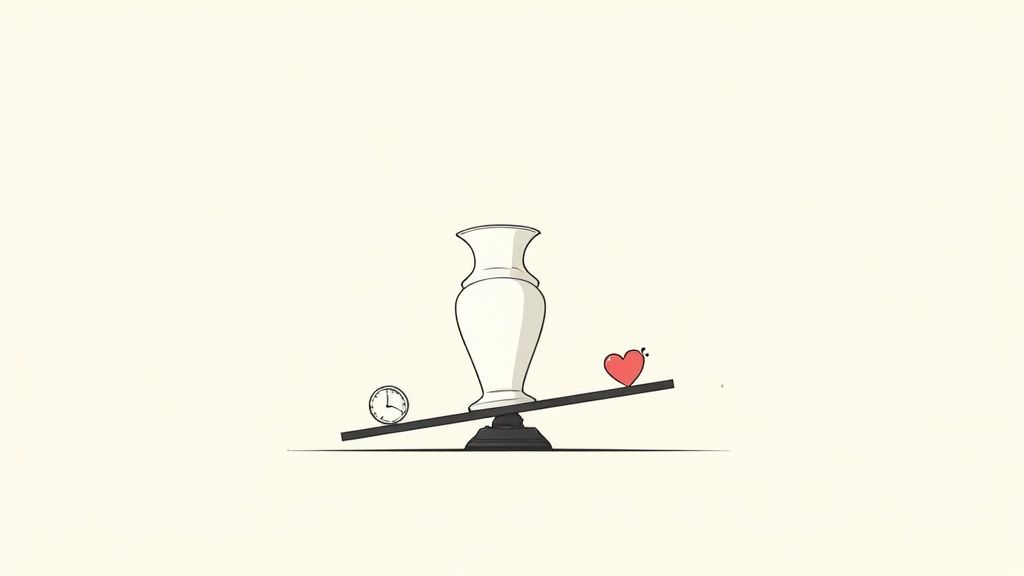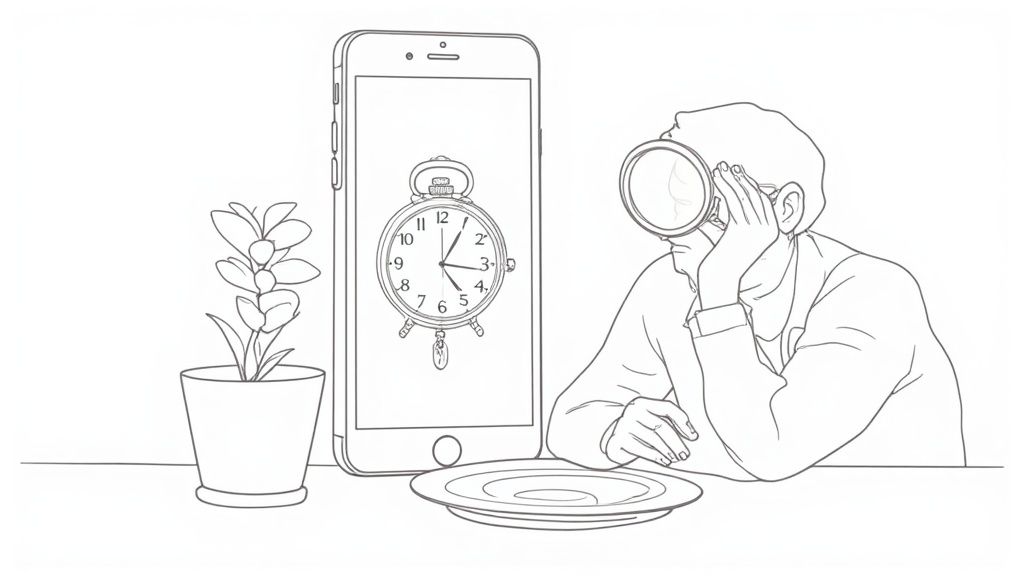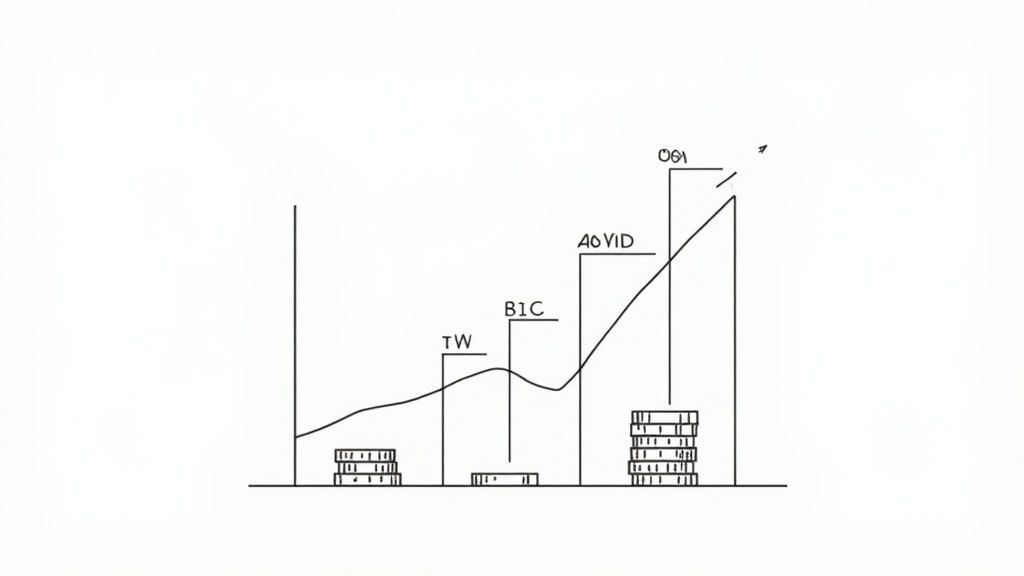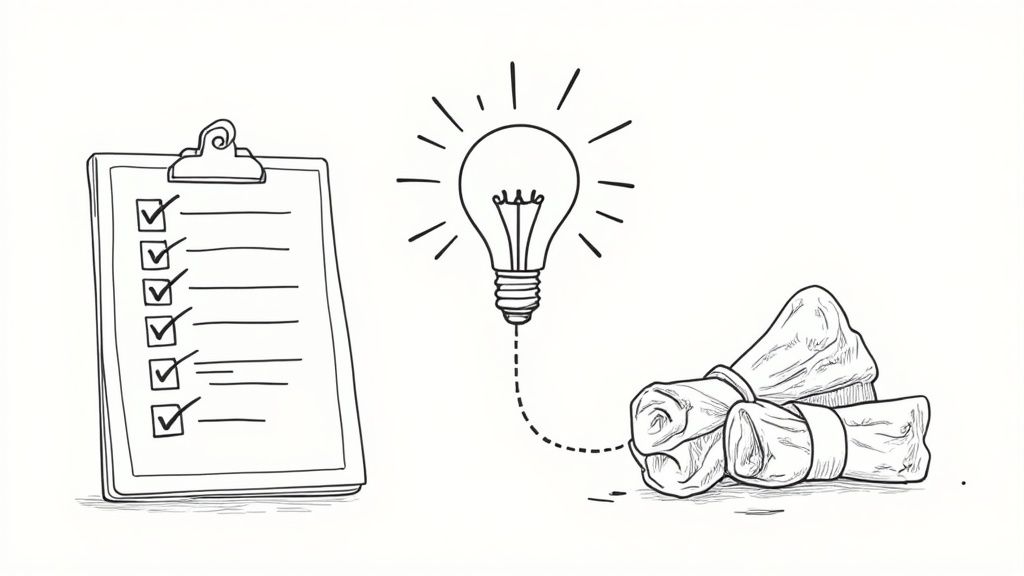Understanding What Really Drives Antique Appraisal Cost
Imagine walking into a craftsman's workshop. You wouldn't expect the cost of repairing a simple stool to be the same as restoring a centuries-old grandfather clock, would you? The cost of antique appraisal works in much the same way. A common porcelain doll from the 1950s will likely require a less extensive appraisal than, say, a rare 18th-century porcelain figurine. This difference in cost comes down to the level of expertise needed for an accurate assessment.
The world of appraisals has intriguing parallels to other specialized fields. Think of medical diagnoses. A general practitioner can handle common ailments, but you'd need a specialist for complex medical issues. Similarly, a general appraiser might be suitable for everyday items, but specialized knowledge is essential for antiques like clocks, fine jewelry, or historical documents. This expertise directly influences the appraisal cost.
However, the antique's value isn't the only factor determining the expense. The global antiques market reached $58.4 billion in 2024, demonstrating the market's size and complexity. High-end antiques often require specialized appraisers capable of providing detailed reports on an item’s history (provenance) and verifying that it's genuine. This significantly impacts the cost, with these in-depth appraisals ranging from a few hundred to several thousand dollars. To delve deeper into the expanding antique market, you can find the full research here: Second-hand Collectibles Market Report 2025.
Even seemingly simple items can have hidden complexities. Consider two antique chairs: one mass-produced, the other handcrafted by a renowned furniture maker. The latter, with its unique history and craftsmanship, requires a far more detailed appraisal. For more guidance on evaluating antiques, check out our helpful guide: How to Find the Value of Antiques. Understanding these nuances allows you to approach the appraisal process with realistic expectations.
Decoding Appraisal Fee Structures That Actually Make Sense

Getting a handle on antique appraisal costs can feel like navigating a maze, but understanding the fee structures is key to managing your budget. Think of it like hiring any professional – different approaches fit different situations.
Appraisers, like lawyers or consultants, sometimes use an hourly rate. This offers transparency, showing exactly how much time is spent evaluating your piece. It’s great for simpler items, but imagine a complex antique with a mysterious past – those hours can add up quickly.
Another common practice is the flat project fee. Similar to a contractor giving you a total renovation price, this offers upfront certainty. This works well for intricate pieces where research time is unpredictable. Knowing the full antique appraisal cost from the start allows for smarter planning, like when appraising an entire collection.
Finally, there's the percentage-based fee, tied to the item’s appraised value. This can be good for lower-value items, keeping costs reasonable. However, with high-value items, those percentages can become significant. It’s vital to understand the potential impact before agreeing to this model.
Let’s break down these different fee structures in a handy table:
Antique Appraisal Fee Structures Comparison
Comparison of different pricing models used by antique appraisers, including typical rates and when each is most appropriate
| Pricing Model | Typical Rate Range | Best For | Pros | Cons |
|---|---|---|---|---|
| Hourly Rate | $50-$250+ per hour | Simpler items, quick evaluations | Transparent, good for shorter projects | Can become expensive for complex items requiring extensive research |
| Flat Project Fee | Varies widely based on project scope | Complex items, collections, predictable budgeting | Upfront cost certainty, good for longer projects | May be overpaying for simple appraisals |
| Percentage-Based Fee | 0.5%-5% of appraised value | Lower-value items, aligning cost with value | Keeps appraisal costs proportionate to value | Can lead to high fees for high-value items |
As you can see, each pricing model has its advantages and disadvantages. Carefully considering your specific needs and the complexity of the item being appraised will help you choose the most suitable option.
Unveiling the Hidden Costs in Antique Appraisals
Beyond the main fee, other costs can creep in. Think travel expenses, especially for in-person examinations. Specialized testing or authentication might be necessary for certain items. And extras like detailed reports or professional photographs can add to the final bill. These seemingly small things can make a difference.
Choosing the Right Fee Structure for Your Needs
So, which fee structure is best? It depends. For a quick appraisal of a common item, an hourly rate might be perfect. For a complex or high-value piece, a flat project fee offers predictable budgeting. Have multiple items? Bundling them could get you a discount. Looking for general pricing guidance? Check out Curio's Antique Price Guide.
Negotiating fees and outlining services upfront is crucial. By understanding the various pricing models and potential hidden costs, you can navigate the appraisal process with confidence and manage expenses effectively.
Why Some Antiques Cost A Fortune To Appraise

Imagine you need an expert opinion. You have two items: a handwritten Beethoven manuscript and a vintage Coca-Cola bottle. It's easy to see why authenticating the Beethoven would be significantly more complex (and costly) than the Coke bottle, right? This illustrates the core reason behind the varying costs of antique appraisal. The level of required expertise plays a huge role.
Some items demand highly specialized knowledge, the kind that comes only with years of focused study. Naturally, this expertise commands a premium.
Let's take Asian ceramics as an example. Think about the depth of knowledge needed for proper appraisal. It requires a cultural historian, someone who understands not only the artistry, but also the specific dynastic periods and regional techniques that establish authenticity. These appraisers are like specialists in the medical field. Just as a brain surgeon commands higher fees than a general practitioner, the in-depth knowledge of a ceramics expert justifies a premium. This means the appraisal cost for a Ming vase will dwarf that of a 1950s ceramic figurine.
Another good illustration is mechanical watches. These intricate machines necessitate a horologist, someone who can spot the tiniest movement modifications—changes invisible to the untrained eye. They're the master mechanics of the watch world, able to diagnose a complex issue by the subtlest of sounds. A general appraiser simply wouldn't have the specialized knowledge to deliver an accurate assessment. This, again, pushes up the appraisal cost.
The Art of Authentication
Fine art appraisal presents another level of complexity. Authentication in this area often relies on provenance researchers. These individuals painstakingly trace an artwork's ownership, a process that can span centuries and tumultuous historical events. Think of them as historical detectives, piecing together fragmented evidence to prove authenticity. Their work often involves sifting through records of war, theft, and inheritance disputes – complex work that necessitates a higher appraisal cost.
These examples demonstrate how the depth of required expertise can dramatically influence appraisal pricing. High-value or rare items demanding specialist appraisers command higher fees, much like specialized medical procedures cost more than general check-ups. As we'll see later, by exploring real-world appraisal examples, these higher costs are often justified by the protection they offer against costly authentication errors and misattributions. Understanding the nuances of specialized appraisal will help you make informed decisions about your own valuable possessions.
How Market Growth Is Reshaping Appraisal Pricing

The antique world is far from a dusty, forgotten corner of the world. It's a dynamic market, and it’s experiencing a real revival. This has a direct impact on how much an antique appraisal costs.
Think of it like a beloved band reuniting for a comeback tour. Suddenly, tickets that were once affordable become hot commodities, and prices shoot up because of the surge in demand.
The same principle applies to antiques. As more people recognize their value, the need for expert appraisal services grows, creating a ripple effect on pricing.
This market growth presents both opportunities and challenges. The increased interest encourages greater specialization within the field.
Specialization and Expertise in a Growing Market
Just as a thriving music scene gives rise to niche genres, the expanding antique market encourages appraisers to develop deep expertise in specific areas. This might be anything from vintage watches to antique furniture.
This specialized knowledge, while valuable, doesn’t come for free. It can contribute to a higher antique appraisal cost, especially for niche or highly sought-after items.
Another factor to consider is the rising stakes associated with increased collector activity. As the value of certain antique categories climbs, so does the potential liability for appraisers. This impacts their insurance costs, which in turn affects what they charge.
Imagine insuring a priceless Stradivarius violin versus a common student model. The risk is vastly different, and so is the price of the insurance.
The global collectibles market, encompassing antiques, is predicted to reach $902 billion by 2035, with a compound annual growth rate (CAGR) of 7.2%. This growth further emphasizes the increasing value of antique items, and consequently, the cost of appraisal services. For a deeper dive into the collectibles market, you can explore this report: Collectibles Market Report.
The Digital Shift in Antique Appraisals
Market growth isn't the only factor influencing appraisal prices. The shift to digital is also playing a significant role. Online platforms and virtual consultations are becoming increasingly common, offering the potential for cost savings.
These digital tools make appraisals more accessible, connecting collectors with experts across the globe. However, this transition requires appraisers to adapt and invest in new technologies. This can initially influence pricing as they navigate this changing landscape.
Navigating Supply and Demand in the Appraisal Market
The increasing demand for appraisals sometimes outstrips the available supply of qualified professionals. This scarcity of expertise, particularly in specialized areas, can further drive up costs.
Think of it like a housing shortage. When demand outpaces supply, prices inevitably rise. Similarly, finding a qualified appraiser for high-demand antique categories becomes more difficult, and therefore, more expensive.
By understanding these market forces, collectors can make smart decisions about when to get an appraisal, how to budget realistically, and which appraisal methods best suit their needs.
Navigating Appraisals and Modern Alternatives
The world of antique appraisals is changing. Along with traditional methods, we now have digital platforms offering new ways to value your treasures. These online services often promise speed and lower costs, but it’s crucial to understand their strengths and weaknesses. A quick online search reveals numerous platforms offering photo-based valuations, but do they offer the same depth of insight as a traditional appraisal? Let's explore the pros and cons of digital options, helping you understand when they're a good fit and when they might fall short.
Understanding the Capabilities of Online Appraisals
Photo-based appraisals offer a convenient starting point. Imagine getting a preliminary medical diagnosis online. It can give you some useful information, but you wouldn't rely on it for a complex medical condition. Similarly, online appraisals work well for common items or getting a general idea of value. They can give you a rough estimate of potential antique appraisal costs and maybe some clues for further research. However, they lack the nuance of a hands-on appraisal, where an expert can carefully examine the object’s condition, materials, and craftsmanship in person.
The Power of Virtual Consultations
Virtual consultations take digital appraisals a step further. Think of them as a video call with your doctor. You can interact with an appraiser in real-time, who can guide you through the process and ask specific questions. This is more interactive than simply uploading photos, but still relies on the information you provide. Just as a doctor needs accurate patient history, a virtual appraisal depends on clear descriptions and high-quality images. For example, when appraising jewelry, clear close-ups of hallmarks and any damage are critical.
Blending Traditional and Digital
This is where things get interesting. Some services combine the efficiency of online tools with the expertise of traditional appraisals. Imagine getting an initial online assessment, followed by a targeted in-person evaluation of key features. This hybrid approach balances convenience and accuracy, making it a compelling option for many collectors. Emerging technologies also play a role. Blockchain provenance tracking, for example, is changing how we document an item's history, adding another layer of authenticity to online transactions.
The antiques market is a dynamic space. Online transactions in art and antiques saw a slight dip, dropping by 11% in 2024 to $10.5 billion. Even with this fluctuation, there’s growing interest in digital platforms for buying and selling. This impacts appraisal costs by making expert opinions more accessible. Learn more about the digital art market here.
Understanding the digital landscape empowers you to choose the right approach. By considering the complexity of your item and your specific needs, you can use digital tools effectively while ensuring accurate valuations.
Proven Strategies To Maximize Your Appraisal Investment
Smart collectors know that getting the most out of their antique appraisal costs requires a strategic approach. It's like planning a road trip: mapping your route and packing strategically saves time and money. Here are some insider tips to help you keep costs down without compromising the quality of your appraisal.
Preparation: Your First Line of Defense Against High Costs
Think of your appraiser's time as a precious commodity. The more organized you are, the less of it you'll use (and pay for). Gathering key details upfront, like provenance documentation, previous valuations, and even family stories tied to the piece, can significantly reduce billable hours. It's similar to giving your doctor a complete medical history: this background information streamlines the process.
Bundling and Group Appraisals: Economies of Scale
Have multiple items that need appraisal? Bundling them together can often result in discounts. It's the same principle as buying in bulk: the more you appraise at once, the lower the per-item cost can be. Group appraisals, where several collectors combine items for a single session, can offer similar savings. This tactic works best when the items share a category or need the same type of expertise. For instance, antique toy collectors could benefit from a group appraisal, while someone with a collection spanning furniture, jewelry, and fine art might be better served with individual appraisals.
Researching Appraiser Credentials: Finding the Right Fit
Not every appraisal demands the same level of expertise. You wouldn't hire a brain surgeon for a common cold, and you don't always need the most seasoned (and expensive) appraiser for every item. Researching credentials helps you find the right fit for your needs. A general appraiser might suffice for common items, while a specialist is essential for rare or complex pieces.
The Power of the Preliminary Consultation
A preliminary consultation can be a worthwhile investment, especially for high-value or unusual items. Think of it like getting a quote from a contractor before a renovation project. It lets you discuss your needs, understand the appraisal process, and get a clear sense of the cost beforehand. This can prevent unexpected costs later and help you make informed decisions. You might find this helpful: How to Price Estate Sale Items.
Negotiation and Understanding Service Levels
Just as you might negotiate the price of a car, don't hesitate to discuss fees with your appraiser. Clearly outlining the services you need – a verbal appraisal, a detailed written report, or something in between – prevents unnecessary charges.
To help illustrate ways you can save, let’s look at the following table.
Cost-Saving Strategies for Antique Appraisals
This table provides practical approaches to reduce appraisal costs while ensuring quality and accuracy.
| Strategy | Potential Savings | Best Applied When | Important Considerations |
|---|---|---|---|
| Bundling Items | 10-25% | Appraising multiple items at the same time | Ensure items are similar in category or require the same expertise. |
| Group Appraisals | 5-15% | Multiple collectors with similar items needing appraisal | Coordinate scheduling and ensure all parties agree on the appraiser. |
| Preliminary Consultation | Varies | Appraising high-value or complex items | Clarify your needs and get a fee estimate before committing to a full appraisal. |
| Negotiating Fees | Varies | When the quoted price seems high or exceeds your budget | Be respectful and understand the appraiser’s expertise and time commitment. |
| Researching Appraiser Levels | Varies | When the item isn't rare or highly complex | Choose an appraiser with the appropriate level of expertise for your item's needs. |
Understanding the nuances of appraisal pricing and using these strategies can maximize your investment and ensure you get the most accurate valuations for your prized possessions.
Making Smart Decisions About Your Appraisal Investment
This screenshot from the Wikipedia page for "Antique" gives us a helpful overview of the term and how it's used. Notice how it highlights the many different facets of antiques, encompassing all sorts of objects and materials.

The screenshot reminds us that "antique" isn't just about how old something is. Cultural significance, how rare it is, and its condition—these all contribute to an object's classification and, ultimately, its value. This complexity is why making informed choices about antique appraisal costs is so important. You're not just paying someone to tell you how old something is; you're investing in real expertise.
So, now that you understand the factors influencing appraisal costs, the different ways appraisers charge, and why specialized expertise matters, let's talk about making smart decisions for your appraisal needs. Whether you’re dealing with inherited items, thinking about selling a prized possession, or just curious about a flea market find, the following advice will help you navigate the appraisal process with confidence.
Choosing the Right Appraisal Approach
Think about your goals first. Are you appraising for insurance, for settling an estate, or for resale? Each reason needs a different level of detail. Insurance appraisals focus on replacement value: what it would cost to replace the item if it were lost or damaged. Estate settlements usually need fair market value: what the item would likely sell for in a typical transaction. Resale appraisals take current market trends and buyer interest into account. It's like choosing the right doctor—you'd see a cardiologist for a heart problem and an orthopedist for a broken bone. The right appraisal approach depends on what you need.
Budgeting for Your Appraisal
The cost of an appraisal can change quite a bit. A basic online appraisal for something common might be less than $50. A complete evaluation of a complex antique, though, could cost thousands of dollars. Think of it like car repairs—an oil change is a lot less expensive than rebuilding an engine. To budget effectively, you need to consider the item's type, age, potential value, and the level of expertise involved. Appraising a collection of vintage baseball cards, for instance, will probably be less expensive than appraising a rare antique piece of furniture.
Recognizing When Professional Appraisal Is Essential
Online tools and informal opinions can be helpful starting points, but sometimes you really need a professional. Items of significant value, things that might be historically important, or anything that needs expert knowledge justifies the cost of a professional appraisal. It's like needing surgery – while a general practitioner can handle many medical issues, complicated procedures require a specialist’s skill. A professional appraiser offers deep knowledge, experience, and ethical standards, providing accurate and reliable valuations.
Practical Tips for Managing Appraisal Costs
- Bundle items: Appraising several similar items at the same time can often lower the cost for each one.
- Prepare thoroughly: If you have any documentation about the item, information on its history (called provenance), or old appraisals, gathering it beforehand can streamline the process and potentially save the appraiser time.
- Communicate clearly: Talk to the appraiser upfront about what you need and expect to make sure you're both on the same page and to avoid surprises.
- Negotiate fees: Don’t hesitate to discuss fees, especially for larger jobs or if you have several items to appraise.
By using these strategies, you can make smart choices about your appraisal spending, ensuring you get the expertise you need at a price that fits your budget.
Ready to explore the world of antiques? Download Curio today and start uncovering the stories behind your treasures: Curio App
